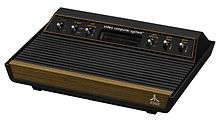Demon Attack
| Demon Attack | |
|---|---|
 | |
| Developer(s) | Imagic |
| Publisher(s) | Imagic |
| Designer(s) | Rob Fulop |
| Programmer(s) |
Atari 2600: Mark Voorsanger[1] |
| Platform(s) |
Atari 2600 (original) Atari 8-bit, VIC-20, Commodore 64, Intellivision, Odyssey², PC Booter, TI-99/4A, TRS-80.[2] |
| Release | 1982 |
| Genre(s) | Fixed shooter |
| Mode(s) | Single-player, 2 player alternating |
Demon Attack is a video game written by Rob Fulop and published by Imagic. It was originally for the Atari 2600, then ported to the Intellivision, Odyssey², Atari 8-bit family, VIC-20, Commodore 64, PC (booter), TRS-80 and TRS-80 Color Computer. There was also a port to the TI-99/4A titled Super Demon Attack.
Demon Attack is supposedly based on the 1979 arcade shooter Galaxian, though it closely resembles several waves from the 1980 arcade game Phoenix.[3] The similarities prompted a lawsuit from Atari, who had purchased the latter's home video game rights.[4] Imagic settled out of court, and Demon Attack became Imagic's best-selling game as of 1983.[5]
Gameplay

Marooned on the ice planet Krybor, the player uses a laser cannon to destroy legions of demons that attack from above. Visually, the demons appear in waves similar to other space-themed shooters, but individually combine from the sides of the screen to the area above the player's cannon.
Each wave introduces new weapons with which the demons attack, such as long streaming lasers and laser clusters. Starting in Wave 5, demons also divide into two smaller, bird-like creatures that eventually attempt descent onto the player's cannon. Starting in Wave 9, the demons' shots follow directly beneath the monsters, making it difficult for the player to slip underneath to get in a direct shot.
Development
The game was originally programmed to end after the 84th wave, as Fulop did not expect anyone to get so far. Two days after initial release however, the game was reported beaten. After this initial run of cartridges, Fulop went back and changed a single line of code so that the game never ends, but gets no harder.[3]
The Odyssey² version was the first third-party game for the console.[6]
Reception
Commenting on Demon Attack's critical reception, AllGame described it as "one of the most critically praised Atari 2600 games of all time."[7] The (Atari)VCS version is considered to be a classic by many Atari fans.[8]
Jan Yarnot reviewed the Atari version of Demon Attack in The Space Gamer No. 53.[9] Yarnot commented that "This game is interesting and enjoyable, and different enough from other cartridges to recommend it for all who must 'play Atari today.' The price is in line with other such programs and I think the fun of the game makes the price reasonable."[9]
Video magazine reviewed the VCS version of Demon Attack in 1982, describing it as "quite simply excellent", and characterizing it as a "true coin-op-level program".[10] Covering the game again in its 1982 Guide to Electronic Games, Video editors called the cartridge "a state-of-the-art invasion game" and suggested that its "slick graphics" represented "a quantum leap for the VCS",[11]:52 however Video reserved higher praise for the Intellivision version of the game which was described as "even more thrilling graphically than the original VCS edition".[11]:53 Video Games praised the Intellivision version of the game, stating that "while the VCS version is a very good TV-game, this one is even better".[5] Ahoy! called the VIC-20 version "excellent ... it's a super-grabber type of twitch game, and good for a few long nights".[12] Demon Attack won the 1983 Arcade Award for "Best Videogame of the Year",[13] with the judges commenting that the game had "turned out to be yardstick against which gamers measured the quality of each new cartridge during 1982".[14]:30
References
- 1 2 3 4 5 6 Hague, James. "The Giant List of Classic Game Programmers".
- ↑ Demon Attack at MobyGames
- 1 2 Stilphen, Scott. "DP Interviews... Rob Fulop", Digital Press.
- ↑ "Player 3 Stage 1: Pixel Boxes". The Dot Eaters. Retrieved 2007-12-18.
- 1 2 Wiswell, Phil (March 1983). "New Games From Well-Known Names". Video Games. p. 69. Retrieved 26 May 2014.
- ↑ Katz, Arnie; Kunkel, Bill (June 1983). "Programmable Arcade". Electronic Games. pp. 38–42. Retrieved 6 January 2015.
- ↑ Weiss, Brett Alan. "Demon Attack". AllGame. Archived from the original on November 14, 2014. Retrieved January 6, 2015.
- ↑ Barton, Matt and Bill Loguidice. "A History of Gaming Platforms: Atari 2600 Video Computer System/VCS". Gamasutra. 28 February 2008.
- 1 2 Yarnot, Jan (July 1982). "Capsule Reviews". The Space Gamer. Steve Jackson Games (53): 34.
- ↑ Kunkel, Bill; Katz, Arnie (August 1982). "Arcade Alley: The Imagic Show". Video. Reese Communications. 6 (5): 14. ISSN 0147-8907.
- 1 2 Kunkel, Bill; Katz, Arnie (November 1982). "Video's Guide to Electronic Games". Video. Reese Communications. 6 (8): 47–56, 108. ISSN 0147-8907.
- ↑ Salm, Walter (March 1984). "VIC Game Buyer's Guide". Ahoy!. p. 49. Retrieved 27 June 2014.
- ↑ "The Players Guide to Fantasy Games". Electronic Games. June 1983. p. 47. Retrieved 6 January 2015.
- ↑ Kunkel, Bill; Katz, Arnie (February 1983). "Arcade Alley: The Fourth Annual Arcade Awards". Video. Reese Communications. 6 (11): 30, 108. ISSN 0147-8907.
External links
- Demon Attack at the Internet Archive Console Living Room
- Demon Attack (Atari 2600) at AtariAge
- Demon Attack at MobyGames
